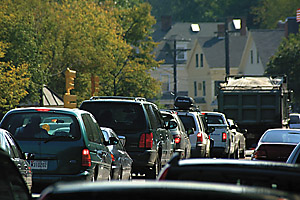 | More than 100 million people in the United States live in areas that exceed national ozone standards. |
Even at very low levels, ozone -- the principal ingredient in smog -- increases the risk of premature death, according to a nationwide study to be published in the April edition of the journal Environmental Health Perspectives.
Ozone, a gas that occurs naturally in the upper atmosphere, is created in the lower atmosphere when vehicle and industrial emissions react with sunlight. Levels typically rise when sunlight and heat are highest in the summer.
The study, sponsored by the Environmental Protection Agency (EPA) and the Centers for Disease Control, found that if a safe level for ozone exists, it is only at very low or natural levels and far below current U.S. and international regulations. A 10-part-per-billion increase in the average of the two previous days' ozone levels is associated with a 0.30% increase in mortality.
The current study builds on research published in November 2004 in the Journal of the American Medical Association, which was the first national study of ozone and mortality.
"This study investigates whether there is a threshold level below which ozone does not affect mortality," says Michelle Bell, lead investigator on the study and assistant professor of environmental health at the School of Forestry & Environmental Studies.
"Our findings show that even if all 98 counties in our study met the current ozone standard every day, there would still be a significant link between ozone and premature mortality," she notes. "This indicates that further reductions in ozone pollution would benefit public health, even in areas that meet regulatory requirements."
Researchers found that even for days that currently meet the EPA limit for an acceptable level of ozone -- 80 parts per billion for an eight-hour period -- there was still an increased risk of death from the pollutant.
An effort is now under way by the EPA to consider whether more stringent standards for ozone are needed. The agency is mandated to set regulations for ozone under the Clean Air Act.
Francesca Dominici, co-author of the study and associate professor of biostatistics at Johns Hopkins University, says: "Over 100 million people in the United States live in areas that exceed the National Ambient Air Quality Standard for ozone. Elevated concentrations of ozone are also a growing concern for rapidly developing nations with rising levels of ozone from expanding transportation networks."
The study is online at http://ehp.niehs.nih.gov/docs/2006/8816/abstract.html.
T H I S
Ozone causes premature death
even at low levels, study finds W E E K ' S
W E E K ' S S T O R I E S
S T O R I E S![]()
 University divests from its holdings in Sudan . . .
University divests from its holdings in Sudan . . .![]()
![]()
 New degree program promotes 'green' architecture
New degree program promotes 'green' architecture![]()
![]()
 Changing the world -- one spring break at a time
Changing the world -- one spring break at a time![]()
![]()
 University Library launching 'Iraq ReCollection' project
University Library launching 'Iraq ReCollection' project![]()
![]()
 Yale and the 2006 Winter Grames
Yale and the 2006 Winter Grames![]()
 United Way honors Yale for goal-topping campaign
United Way honors Yale for goal-topping campaign![]()
![]()
 Elimelech elected to NAE in honor of work on water-quality control
Elimelech elected to NAE in honor of work on water-quality control![]()
![]()
 Endowment will usher in 'new era' for Yale women's ice hockey
Endowment will usher in 'new era' for Yale women's ice hockey![]()
![]()
 Partnership to increase India's environmental resources
Partnership to increase India's environmental resources![]()
![]()
 Ozone causes premature death even at low levels, study finds
Ozone causes premature death even at low levels, study finds![]()
![]()
 Columnist decries lack of response to genocide in Darfur
Columnist decries lack of response to genocide in Darfur![]()
![]()
 Donated books a 'reminder' of once-blacklisted Yale neuroscientist
Donated books a 'reminder' of once-blacklisted Yale neuroscientist![]()
![]()
 Slifka Center hosting Jewish Alumni Weekend
Slifka Center hosting Jewish Alumni Weekend![]()
![]()
 More on the Grammys ...
More on the Grammys ...![]()
![]()
 Campus Notes
Campus Notes![]()
Bulletin Home |
| Visiting on Campus
Visiting on Campus |
| Calendar of Events
Calendar of Events |
| In the News
In the News![]()
Bulletin Board |
| Classified Ads
Classified Ads |
| Search Archives
Search Archives |
| Deadlines
Deadlines![]()
Bulletin Staff |
| Public Affairs
Public Affairs |
| News Releases
News Releases |
| E-Mail Us
E-Mail Us |
| Yale Home
Yale Home